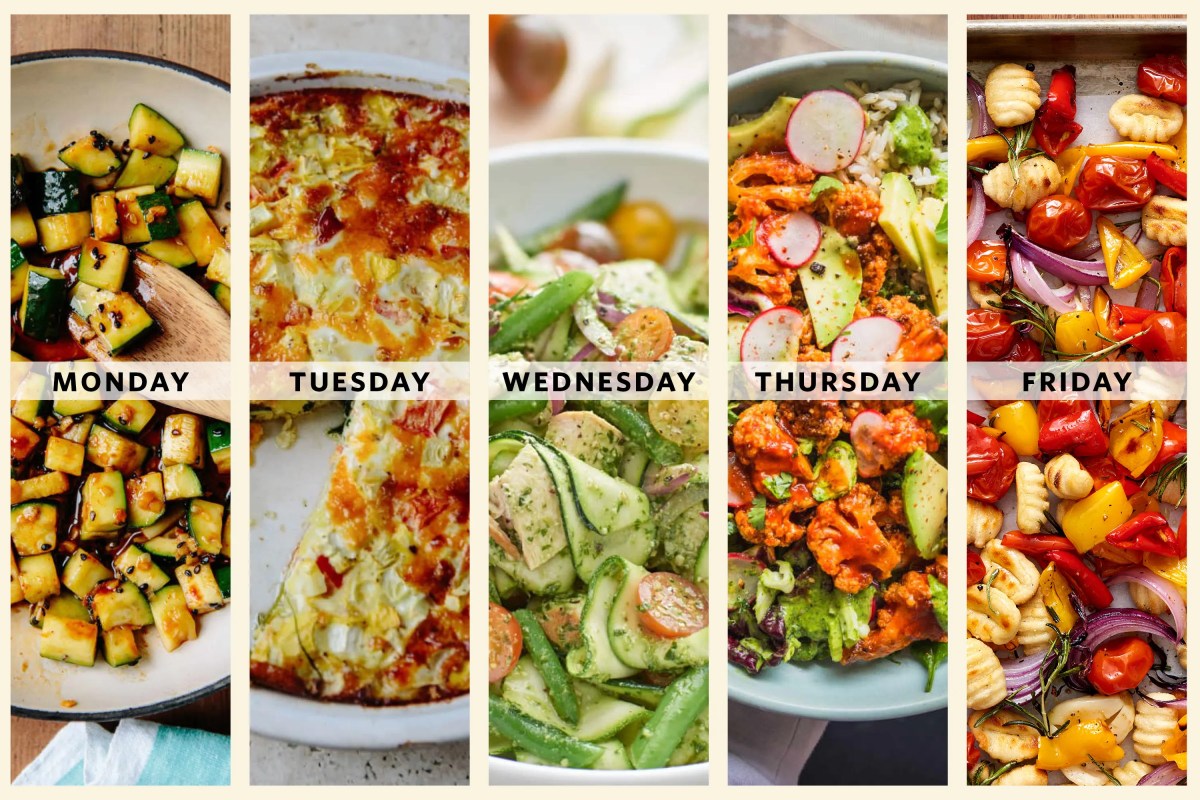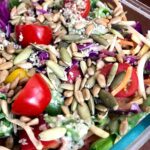Embark on a culinary journey towards a healthier, more sustainable lifestyle with our guide to flexitarian eating. Discover the simple joy of incorporating more plant-based meals into your diet without the rigidity of strict vegetarianism or veganism. We’ll unveil the secrets to a smooth transition, armed with easy-to-follow recipes that are both delicious and satisfying. Imagine vibrant colors, tantalizing aromas, and textures that dance on your palate – a flexitarian diet is a celebration of flavor and mindful eating.
This comprehensive guide provides a step-by-step approach, starting with a clear understanding of flexitarianism and its numerous benefits. We’ll then dive into a collection of simple, beginner-friendly recipes, each designed to showcase the versatility and deliciousness of plant-based ingredients. Practical meal planning advice, grocery shopping tips, and solutions to common challenges will ensure a seamless transition to this rewarding way of eating. Prepare to expand your culinary horizons and embrace a healthier, more sustainable you.
Simple and Delicious Flexitarian Recipes
Embarking on a flexitarian journey doesn’t require culinary expertise. Simple, flavorful meals are the cornerstone of a successful transition, making it enjoyable and sustainable. The following recipes showcase how easily you can incorporate more plant-based options into your diet without sacrificing taste or convenience.
Five Easy Flexitarian Recipes for Beginners
These recipes are designed for ease of preparation and maximum flavor, perfect for those new to flexitarian eating. They utilize readily available ingredients and require minimal cooking skills.
| Recipe Name | Ingredients | Summary | Cooking Time |
|---|---|---|---|
| One-Pan Lemon Herb Roasted Chicken and Vegetables | Chicken thighs, potatoes, carrots, broccoli, lemon, herbs (rosemary, thyme), olive oil, salt, pepper | A complete meal in one pan, featuring tender chicken and roasted vegetables infused with bright lemon and herb flavors. | 45 minutes |
| Black Bean Burgers | Black beans, breadcrumbs, onion, garlic, spices (cumin, chili powder), egg (optional), olive oil | Hearty and flavorful vegetarian burgers, perfect for a quick and satisfying meal. | 30 minutes |
| Lentil Soup | Red lentils, carrots, celery, onion, vegetable broth, spices (cumin, turmeric), coconut milk (optional) | A warming and nutritious soup packed with protein and fiber. | 30 minutes |
| Quinoa Salad with Roasted Sweet Potatoes and Chickpeas | Quinoa, sweet potatoes, chickpeas, red onion, feta cheese (optional), parsley, lemon vinaigrette | A vibrant and flavorful salad, perfect for a light lunch or dinner. | 40 minutes |
| Shrimp Scampi with Zucchini Noodles | Shrimp, zucchini, garlic, white wine, lemon juice, butter, parsley, red pepper flakes | A lighter take on classic scampi, using zucchini noodles instead of pasta for a lower-carb option. | 20 minutes |
A Visually Appealing Flexitarian Pasta Dish: Creamy Tomato and Spinach Pasta with Roasted Cherry Tomatoes
This recipe showcases a vibrant and flavorful pasta dish, balancing the richness of creamy tomato sauce with the freshness of spinach and the sweetness of roasted cherry tomatoes.
Imagine a plate brimming with swirls of creamy, rosy tomato sauce clinging to perfectly cooked pasta. Emerald green spinach leaves peek out from beneath, adding a pop of color and freshness. Scattered across the surface are glistening roasted cherry tomatoes, their skins slightly blistered, their interiors bursting with sweetness. The sauce has a smooth, velvety texture, contrasting beautifully with the slightly firm bite of the pasta and the tender spinach. The colors are rich and inviting: deep reds from the sauce and tomatoes, vibrant greens from the spinach, and the warm golden hue of the pasta. The dish is plated simply, allowing the natural beauty of the ingredients to shine. A sprinkle of fresh basil adds a final touch of green, enhancing the visual appeal and adding a subtle peppery aroma.
Three Lentil-Based Recipes
Lentils are an excellent source of plant-based protein and fiber, offering significant nutritional benefits. These recipes highlight the versatility of lentils in various cuisines.
Recipe 1: Spicy Red Lentil Curry: Red lentils cook quickly and create a creamy texture perfect for curries. This recipe combines the earthy flavor of lentils with warming spices like cumin, coriander, and turmeric, along with coconut milk for richness. Nutritional benefits include high protein, fiber, and iron content. Preparation involves sautéing onions and garlic, adding spices, then lentils and broth, simmering until tender. A final stir of coconut milk adds creaminess.
Recipe 2: Lentil Shepherd’s Pie: This hearty dish replaces traditional ground meat with lentils, creating a vegetarian version that’s equally satisfying. The lentils are simmered with vegetables like carrots and celery, creating a flavorful base. This is topped with a layer of creamy mashed sweet potatoes or regular potatoes for a comforting and nutritious meal. Nutritional highlights include fiber, protein, and vitamins from the vegetables.
Recipe 3: Lentil Salad with Lemon Vinaigrette: This light and refreshing salad showcases the versatility of lentils in a cold dish. Cooked lentils are combined with chopped vegetables like cucumbers, tomatoes, and red onion, tossed with a zesty lemon vinaigrette. Feta cheese or toasted nuts can be added for extra flavor and texture. This salad provides a good source of protein, fiber, and vitamins, making it a perfect light lunch or side dish.
Meal Planning and Grocery Shopping for Flexitarians
Embarking on a flexitarian journey involves a delightful shift in culinary habits, and mastering meal planning and grocery shopping is key to a smooth and successful transition. A well-structured plan ensures you enjoy diverse, delicious meals while minimizing food waste and maximizing your budget. This section will guide you through creating a sample weekly meal plan and corresponding grocery list, along with practical tips for efficient shopping.
Effective meal planning is the cornerstone of a successful flexitarian diet. It helps you make conscious choices, reduces impulsive unhealthy food purchases, and ensures a balanced intake of nutrients. Careful grocery shopping complements this, preventing unnecessary spending and reducing food waste.
A Sample Weekly Flexitarian Meal Plan
This sample plan demonstrates a balanced approach, incorporating both vegetarian and meat-inclusive meals. Remember to adjust portion sizes to your individual needs and preferences. Variety is key to maintaining interest and ensuring nutritional completeness.
| Day | Breakfast | Lunch | Dinner |
|---|---|---|---|
| Monday | Overnight Oats with Berries and Nuts | Lentil Soup with Whole-Wheat Bread | Grilled Salmon with Roasted Asparagus and Quinoa |
| Tuesday | Greek Yogurt with Fruit and Granola | Leftover Salmon and Quinoa | Vegetarian Chili with Cornbread |
| Wednesday | Scrambled Eggs with Spinach and Whole-Wheat Toast | Salad with Chickpeas and Feta Cheese | Chicken Stir-fry with Brown Rice |
| Thursday | Smoothie with Spinach, Banana, and Almond Milk | Leftover Chicken Stir-fry | Black Bean Burgers on Whole-Wheat Buns with Sweet Potato Fries |
| Friday | Whole-Wheat Pancakes with Fruit | Tuna Salad Sandwich on Whole-Wheat Bread | Pasta with Marinara Sauce and Vegetables |
| Saturday | Breakfast Burrito with Scrambled Eggs, Black Beans, and Salsa | Leftover Pasta | Pizza with Vegetables and a small amount of Chicken or Sausage |
| Sunday | French Toast with Berries | Salad with Grilled Chicken or Tofu | Roast Chicken with Roasted Potatoes and Green Beans |
Comprehensive Grocery List for the Weekly Meal Plan
This list is categorized for easy shopping and organization. Remember to check your pantry and refrigerator before heading to the store to avoid duplicate purchases. Consider buying seasonal produce for better quality and lower prices.
Organizing your grocery list by food group simplifies shopping and ensures you have all the necessary ingredients. This approach also helps in maintaining a balanced diet and minimizes impulsive purchases.
| Food Group | Items |
|---|---|
| Produce | Berries, bananas, spinach, asparagus, corn, sweet potatoes, potatoes, green beans, onions, garlic, tomatoes, lettuce, cucumbers |
| Grains | Whole-wheat bread, quinoa, brown rice, whole-wheat buns, pasta, cornbread mix, whole-wheat pancakes mix |
| Protein | Salmon, chicken, eggs, black beans, chickpeas, lentils, tuna, feta cheese, nuts, Greek yogurt, chicken sausage (optional) |
| Dairy/Alternatives | Greek yogurt, almond milk |
| Pantry Staples | Oats, granola, olive oil, spices (salt, pepper, etc.), marinara sauce, salsa |
Tips for Efficient Grocery Shopping and Minimizing Food Waste
Efficient grocery shopping practices are crucial for a successful flexitarian diet. Careful planning and mindful purchasing reduce both costs and environmental impact. Reducing food waste is also a significant step towards sustainability.
These strategies combine planning, smart purchasing, and creative meal preparation to minimize waste and maximize the value of your groceries. They align perfectly with the flexitarian philosophy of mindful and responsible eating.
- Plan your meals before you shop: Using a meal plan like the one above ensures you buy only what you need.
- Shop the perimeter of the store: Fresh produce, meat, and dairy are typically located around the edges, while processed foods are often in the center aisles.
- Check your pantry and refrigerator: Avoid buying duplicates by taking inventory before you go.
- Buy in bulk for staples, but only what you can realistically use: This is particularly useful for items like grains and beans.
- Use leftovers creatively: Transform leftover chicken into salads or soups, and repurpose vegetables in frittatas or stir-fries.
- Freeze excess produce: Many fruits and vegetables freeze well, extending their shelf life.
- Learn to love your freezer: Freeze leftover portions of meals to enjoy later, reducing food waste.
Addressing Common Challenges and Concerns

Embarking on a flexitarian journey is a rewarding experience, but it’s not always smooth sailing. Many individuals encounter hurdles along the way, often stemming from social situations and navigating the culinary landscape. Understanding these common challenges and developing effective strategies is crucial for long-term success. This section addresses these obstacles and offers practical solutions to help you maintain your flexitarian lifestyle effortlessly.
Navigating social situations and dining out can present significant challenges for new flexitarians. The abundance of meat-centric options at social gatherings and restaurants can feel overwhelming, leading to feelings of isolation or pressure to conform. However, with a proactive approach, these situations can be managed with grace and ease.
Social Situations and Gatherings
Successfully integrating a flexitarian diet into social settings requires thoughtful planning and clear communication. Imagine a vibrant barbecue, sizzling with the aroma of grilled meats. Instead of feeling excluded, prepare in advance. Bring a delicious vegetarian or flexitarian dish to share – a vibrant quinoa salad with roasted vegetables, a flavorful lentil stew, or even a gourmet grilled vegetable skewer. This not only provides you with a satisfying meal but also introduces others to the delicious possibilities of plant-based cuisine. By showcasing the appealing nature of your choices, you subtly encourage others to consider more plant-based options themselves. Openly communicating your dietary preferences also helps; friends and family, once informed, are usually very accommodating and happy to support your journey.
Finding Suitable Restaurants
Dining out as a flexitarian can initially feel daunting, particularly in areas with limited vegetarian or vegan options. However, a bit of research and a strategic approach can transform this challenge into an exciting culinary adventure. Before heading out, check restaurant menus online – many establishments now clearly label vegetarian and vegan choices. Look for restaurants specializing in international cuisines, as many cultures naturally incorporate a wealth of plant-based dishes. Indian, Mediterranean, and Thai food, for example, often offer a wide variety of vegetarian and flexitarian-friendly options. Don’t hesitate to contact the restaurant directly to inquire about modifications to existing dishes or the possibility of creating a custom flexitarian meal. Remember, many chefs are happy to accommodate dietary requests, especially when presented politely and with understanding.
Overcoming Plateaus and Maintaining Motivation
Maintaining a flexitarian diet long-term requires consistent effort and a proactive approach to overcoming potential plateaus. One common challenge is the feeling of missing out on familiar meat-based dishes. To counteract this, explore new and exciting plant-based recipes and culinary techniques. Experiment with flavorful spices, herbs, and sauces to enhance the taste and texture of your meals. Consider joining online flexitarian communities or attending cooking classes to learn new recipes and gain inspiration. Connecting with like-minded individuals provides a supportive network and helps maintain motivation. Celebrate your successes along the way, acknowledging your progress and rewarding yourself with non-food related treats, such as a new cookbook or a relaxing spa day.
Success Stories and Testimonials
“Initially, I felt overwhelmed by the prospect of transitioning to a flexitarian diet. However, by starting slowly and focusing on incorporating more plant-based meals into my routine, I found the process surprisingly manageable. Now, I feel healthier, more energetic, and I’ve discovered a whole new world of delicious and satisfying plant-based recipes.” – Sarah J.
This testimonial highlights the common experience of feeling initially overwhelmed, but finding success through a gradual approach and the discovery of new culinary possibilities. Many individuals find that the transition is easier than anticipated, once they begin to explore the diverse and exciting world of plant-based cuisine. The positive impact on health and well-being further reinforces their commitment to this lifestyle choice.
Recipes Focused on Specific Dietary Needs
Adapting recipes to suit various dietary needs is a key aspect of flexitarian eating. This allows for greater flexibility and inclusivity, ensuring everyone can enjoy delicious and healthy meals. The following recipes demonstrate how to create satisfying dishes tailored to gluten-free, low-carb, and high-protein preferences.
Gluten-Free Lentil Shepherd’s Pie
This hearty and comforting shepherd’s pie replaces traditional mashed potatoes with a creamy, gluten-free sweet potato topping. The lentil base is packed with protein and fiber.
- Preheat oven to 375°F (190°C). Lightly grease a 9×13 inch baking dish.
- In a large pot, sauté 1 chopped onion and 2 carrots (diced) in 2 tablespoons olive oil until softened. Add 1 pound of brown or green lentils, 4 cups vegetable broth, 1 teaspoon dried thyme, 1/2 teaspoon salt, and 1/4 teaspoon black pepper. Bring to a boil, then reduce heat and simmer for 25-30 minutes, or until lentils are tender.
- While lentils simmer, prepare the topping. Peel and cube 2 large sweet potatoes. Boil until tender, then mash with 2 tablespoons butter, 1/4 cup milk (dairy or non-dairy), and a pinch of salt and pepper.
- Pour the cooked lentils into the prepared baking dish. Spread the mashed sweet potatoes evenly over the lentils.
- Bake for 20-25 minutes, or until the topping is lightly browned and heated through.
Low-Carb Zucchini Noodles with Shrimp and Pesto
This vibrant dish is light, refreshing, and low in carbohydrates, making it an excellent choice for those watching their carb intake. The shrimp provides a boost of lean protein.
- Prepare zucchini noodles using a spiralizer or vegetable peeler. You should aim for long, thin noodles.
- In a large skillet, heat 1 tablespoon olive oil over medium heat. Add 1 pound of shrimp and cook for 2-3 minutes per side, until pink and cooked through.
- Add the zucchini noodles to the skillet and cook for 2-3 minutes, until slightly softened but still firm.
- Stir in 1/2 cup pesto (store-bought or homemade), 1/4 cup grated Parmesan cheese (optional), and salt and pepper to taste.
- Serve immediately. Garnish with extra Parmesan cheese and fresh basil, if desired.
High-Protein Quinoa Bowl with Roasted Chickpeas and Avocado
This bowl is a powerhouse of protein and healthy fats, perfect for a satisfying and energizing meal. The roasted chickpeas add a delightful crunch.
- Preheat oven to 400°F (200°C). Toss 1 can (15 ounces) of chickpeas (drained and rinsed) with 1 tablespoon olive oil, 1/2 teaspoon paprika, 1/4 teaspoon cumin, and salt and pepper to taste. Spread on a baking sheet and roast for 20-25 minutes, until crispy.
- Cook 1 cup of quinoa according to package directions.
- While the quinoa cooks and chickpeas roast, prepare the other components. Chop 1/2 cup red onion, 1 cup cherry tomatoes, and 1 avocado.
- Combine the cooked quinoa, roasted chickpeas, red onion, cherry tomatoes, and avocado in a bowl.
- Drizzle with 2 tablespoons of your favorite dressing (e.g., lemon vinaigrette or tahini dressing).
Adapting Existing Recipes to a Flexitarian Lifestyle
Many traditional recipes can be easily adapted to fit a flexitarian lifestyle. For instance, substituting ground turkey or lentils for ground beef in a chili recipe reduces meat consumption while maintaining the hearty flavor. Similarly, swapping out half the cheese in a lasagna recipe with ricotta or vegetables lightens the dish and adds nutritional value. Replacing pasta with zucchini noodles or cauliflower rice in various dishes is another effective method for reducing refined carbohydrates. Experimenting with different vegetables, legumes, and grains allows for endless variations.
Transitioning to a flexitarian diet doesn’t have to be daunting; it’s a journey of discovery, filled with flavorful exploration and mindful choices. By incorporating the simple recipes and practical strategies Artikeld in this guide, you’ll not only enjoy delicious, healthy meals but also contribute to a more sustainable food system. Remember, every flexitarian meal is a step towards a healthier planet and a happier you. So, embrace the flexibility, savor the flavors, and embark on this enriching culinary adventure today. The vibrant colors of fresh vegetables, the hearty textures of lentils, and the satisfying comfort of familiar dishes, all reimagined with a flexitarian twist – await your culinary exploration.
Questions Often Asked
What are the main differences between flexitarian, vegetarian, and vegan diets?
Flexitarian diets emphasize plant-based foods but allow occasional meat consumption. Vegetarian diets exclude meat, poultry, and seafood, while vegan diets exclude all animal products.
Can I still eat out while following a flexitarian diet?
Absolutely! Many restaurants offer vegetarian or easily adaptable options. Look for dishes featuring vegetables, legumes, or grains as the main components.
How do I handle social situations where meat is the main focus?
Communicate your dietary preference politely and proactively. Most people are understanding and accommodating. Suggest alternative dishes or bring a flexitarian-friendly dish to share.
Is it expensive to eat a flexitarian diet?
Not necessarily. Focusing on seasonal produce and legumes can be cost-effective. Planning your meals and shopping strategically minimizes waste and expenses.


